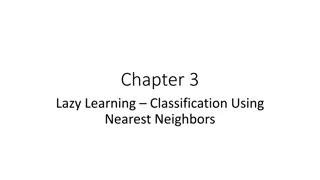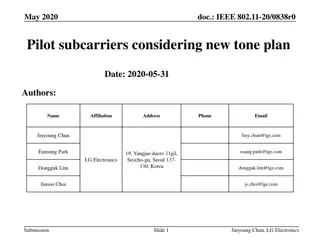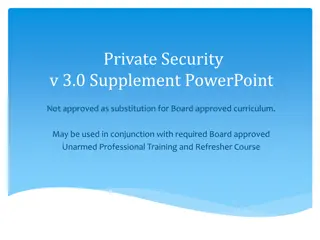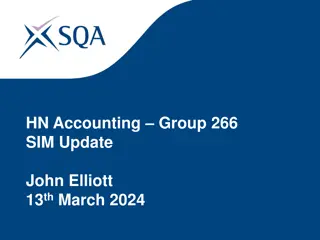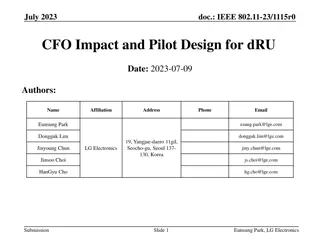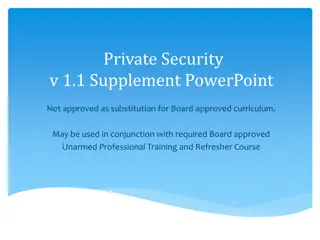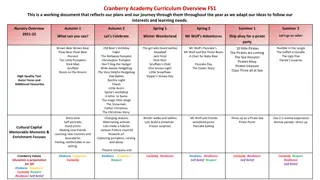Mastering Lazy Eights: Private Pilot Curriculum Overview
Understanding the maneuver of Lazy Eights is crucial for private pilots. This curriculum covers the elements, performance requirements, and the significance of Lazy Eights in developing proper control coordination and proficiency. Learn about the maneuver, why it is essential, and how to execute it effectively in flight training.
Download Presentation

Please find below an Image/Link to download the presentation.
The content on the website is provided AS IS for your information and personal use only. It may not be sold, licensed, or shared on other websites without obtaining consent from the author. Download presentation by click this link. If you encounter any issues during the download, it is possible that the publisher has removed the file from their server.
E N D
Presentation Transcript
Lazy Eights Private Pilot Curriculum Stephen Saslow August 2020
Objective The student should understand the elements and necessary control inputs to perform the lazy eight maneuver. The student should show the ability to perform a coordinated, well planned and oriented lazy eight as prescribed in the ACS/PTS.
Elements of Lazy Eights Relating the Maneuver Performing the Lazy Eight Rudder Control Summary
What are Lazy Eights, Why Do We Learn Them? A maneuver consisting of two 180 degree turns in opposite directions, while making a climb and descent in a symmetrical pattern during each of the turns. It is designed to develop proper coordination of controls through a wide range of airspeeds and attitudes so that certain accuracy points are reached with planned attitude and airspeed. It is the only standard flight training maneuver during which at no time do the forces on the controls remain constant. The lazy eight develops proper coordination of the controls through a wide range of airspeeds and attitudes. It is a great trainer because of the constantly varying forces and attitudes required. It also helps develop subconscious feel, planning, orientation, coordination, and speed sense.
Lazy Eights Relating the Maneuver The maneuver can be compared to a half pipe and a transfer of energy A transfer of energy as we climb the half pipe and then descend on the other side The energy is used to get to the top Constant power setting Then we ride the pipe back down
How To Perform the Lazy Eight
How To Perform the Lazy Eight Before Starting Select an altitude No lower than 1,500 AGL Select an altitude that is easy to read on the altimeter 500 increment Pre-maneuver checklist Ensure the area is clear of traffic Below, at, and above your altitude The airplane should be in straight and level flight at cruise power, at or below VA Choose visual reference points at 45, 90, and 135 degrees in the direction the turn will be in Common Error - Poor selection of reference points Select reference points that are easily identified Don t use points that are too close to your position, ensure that they are toward or on the horizon
How To Perform the Lazy Eight Starting the Lazy Eight The maneuver is started from straight and level flight with a gradual climbing turn in the direction of the 45 degree reference point *VERY gently begin a climb and turn to each reach 15 degree of pitch (max pitch) and bank at the 45 degree point Pitch must be increased faster than bank As pitch is increased airspeed decreases and therefore the rate of turn increases Since the bank is also being increased, the rate of turn is further increasing Unless the maneuver is started with a very slow rate of roll, the combination of increased pitch and increasing bank will cause the rate of turn to be so rapid the 45 degree point will be reached before the highest pitch attitude Decreasing airspeed also means increased torque Right rudder will be necessary to maintain coordination
How To Perform the Lazy Eight At the 45 degree Point The pitch attitude should be at maximum (15 degree) The angle of bank should be at 15o and continue to increase at the same rate The pitch attitude should start to decrease slowly toward the horizon and the 90o reference point Since the airspeed is still decreasing, right rudder pressure will be required to counteract the left turning tendencies of the aircraft As the airspeed slows, the rudder becomes less effective
How To Perform the Lazy Eight 45 to 90 degrees The angle of bank continues to increase to reach 30 degrees of bank at the 90 degree point of the turn Bank continues to increase at the same rate as the first 45 degreesof turn No more than 30 degrees of bank Pitch continues to decrease to pass through level flight at the 90 degree point Decrease at the same rate as the increase in the initial climbing turn As the aircraft continues to slow, additional right rudder pressure will be necessary
How To Perform the Lazy Eight At the 90 degree Point The bank should be at the maximum angle (approximately 30 degree) Opposite aileron may be required to maintain the bank angle This may result in a crossed control situation This is OK, as long as the airplane remains coordinated The airspeed should be at its minimum (5 to 10 knots above the stall speed) Therefore, the rudder pressure required will be the highest The pitch attitude should be passing through level flight Pass through the 90 degree reference point and the horizon simultaneously The airplane should be flown into a descending turn The nose should describe the same size loop below the horizon as it did above When passing through the 90 degree point, the bank should be gradually decreased and the nose allowed to continue lowering Guide the nose down, don t dive
How To Perform the Lazy Eight 90 to 135 degrees Bank is consistently decreased to reach 15 degrees of bank at the 135 degree of turn point Opposite of the beginning of the maneuver Pitch is decreased to reach the maximum pitch down at 135 degrees *Max Pitch down is approximately 5-7 degrees Less than max pitch up since we now have gravity, thrust, and a forward component of lift working together to descend the aircraft Going up we only have thrust, therefore we need to pitch up more aggressively than we pitch down Lift has a rearward component when climbing Airspeed will begin increasing during this descending turn It will be necessary to gradually relax rudder and aileron pressure
How To Perform the Lazy Eight At the 135 degree Point The nose of the airplane should be at its lowest pitch attitude (5 7 degrees) Bank should be at 15 degrees The airspeed will be increasing so it will be necessary to gradually relax rudder and aileron pressure
How To Perform the Lazy Eight 135 to 180 degrees Continue to decrease bank to level the wings Note the amount of turn remaining and adjust the rate of rollout and pitch change so that the wings become level and the original airspeed is attained in level flight just as the 180o point is reached The airspeed will continue to increase so it will be necessary to further relax rudder and aileron pressure Continue to increase pitch to bring the nose back to the horizon Altitude should be where the maneuver was started Why everything needs to come back to the same place: When crop dusting, Come in too high, then wind and other variables will scatter your dust Come in too low, you could hit the ground Come in off heading, then you re going to miss spots/re-cover spots It s going to make a mess
How To Perform the Lazy Eight At the 180 degree Point Upon returning to the starting altitude and the 180o point, a climbing turn should be started immediately in the opposite direction using the same visual references The second turn should mimic the first as closely as possible Common Error - Inconsistent airspeed and altitude at key points Use the recommended pitch, bank and power settings and make adjustments as necessary for mistakes
How To Perform the Lazy Eight Rudder Control Due to the decreasing airspeed, considerable right rudder pressure is gradually applied to counteract the left turning tendencies, such as torque and p-factor, at the top of the eight in both the right and left turns The pressure will be greatest at the point of lowest airspeed More right rudder pressure will be needed during the climbing right turn Right turn rudder has to compensate for the Left Turning Tendencies + Adverse Yaw Sufficient/coordinated right rudder is required to prevent the left yaw from decreasing the rate of turn Left turn Rudder compensates for Left Turning Tendencies Adverse Yaw Adverse yaw counteracts some of the left turning tendencies Less right rudder is required than in a right turn In the climbing right turn, the controls are slightly crossed because of the need for left aileron pressure to prevent overbanking and right rudder to overcome the left turning tendencies
Lazy Eights and the Senses Hearing Visually Feel Listen to the sound of the airflow around the airplane; as the maneuver progresses up the half-pipe , the noise will lessen as the airspeed drops, then increase again on the way down, then repeat Make note of your reference points prior to beginning the maneuver When done correctly, everything should appear in slow motion Control pressures will change throughout the maneuver as the airspeed is constantly changing. Proper rudder use will keep you coordinated
Common Common Errors Errors Poor selection of reference points Uncoordinated use of flight controls Unsymmetrical loops resulting from poorly planned pitch and bank attitude changes Inconsistent airspeed and altitude at key points Loss of orientation Excessive deviation from reference points
How To Perform the Lazy Eight Summary The maneuver requires constantly changing control pressures It is not possible to do a lazy eight mechanically because the control pressures required for perfect coordination are never exactly the same At no time is the maneuver flown straight and level Control pressures change in accordance with varying combinations of climbing and descending turns at varying airspeeds Common Error - Uncoordinated use of flight controls Properly compensate for changing airspeed and left turning tendencies as described above
How To Perform the Lazy Eight Summary (continued) Common Error - Loss of orientation/Excessive deviation from reference points The pilot must learn to divide attention and plan for each segment of the lazy eight Divide attention between the inside and the outside references Do not fixate keep the eyes moving Move between pitch, bank, airspeed, coordination, outside references The more experience the pilot has performing these maneuvers, the more time they can spend on the outside references Preplan the events in each 45 degree segment Talk through the maneuver at each 45o point. Know what you re going to do Altitude targets Airspeed Pitch Bank
How To Perform the Lazy Eight Summary (continued) Common Error - Unsymmetrical loops resulting from poorly planned pitch and bank attitude changes Properly plan pitch and bank attitude changes Don t pitch up or down excessively Aggressive pitch up could result in the airspeed getting too slow too early, or a potential stall Aggressive pitch down could lead to excessive speed Over the maneuver starting speed or VA Bank control Adjust bank to hit the proper bank angles at the reference points Anticipate and compensate for changing airspeeds and the over banking tendency
Performing Lazy Eights Objective: The student should understand the elements and necessary control inputs to perform the lazy eight maneuver. The student should show the ability to perform a coordinated, well planned and oriented lazy eight as prescribed in the ACS/PTS. Purpose: The lazy eight develops proper coordination of the controls through a wide range of airspeeds and attitudes. It is a great trainer because of the constantly varying forces and attitudes required. It also helps develop subconscious feel, planning, orientation, coordination, and speed sense. Commercial Pilot ACS Skills Standards 1. Clear the area. 2. Select an altitude that will allow the maneuver to be performed no lower than 1,500 feet AGL. 3. Establish the recommended entry configuration, power, and airspeed. 4. Maintain coordinated flight throughout the maneuver. 5. Complete the maneuver in accordance with the following: a. Approximately 30 bank at the steepest point b. Constant change of pitch and roll rate and airspeed c. Altitude at 180 point, 100 feet from entry altitude d. Airspeed at the 180 point, 10 knots from entry airspeed e. Heading at the 180 point, 10 degrees 6. Continue the maneuver through the number of symmetrical loops specified, then resume straight-and-level flight. Private Pilot ACS Skills Standards 1. N/A
Lazy Eights: Conclusion It is important that each part of the maneuver is performed at the same speed, or, increases and decreases in both pitch and bank should be made at the same rate during each part of the turn. Each part of the turn should be a mirror image of its opposite. It also is very important to keep the airplane coordinated throughout the varying attitudes and airspeeds in the maneuver.





